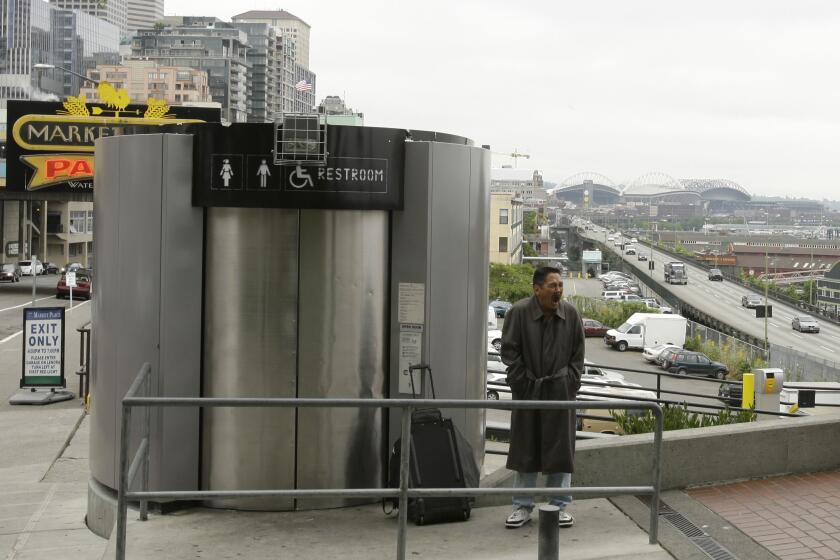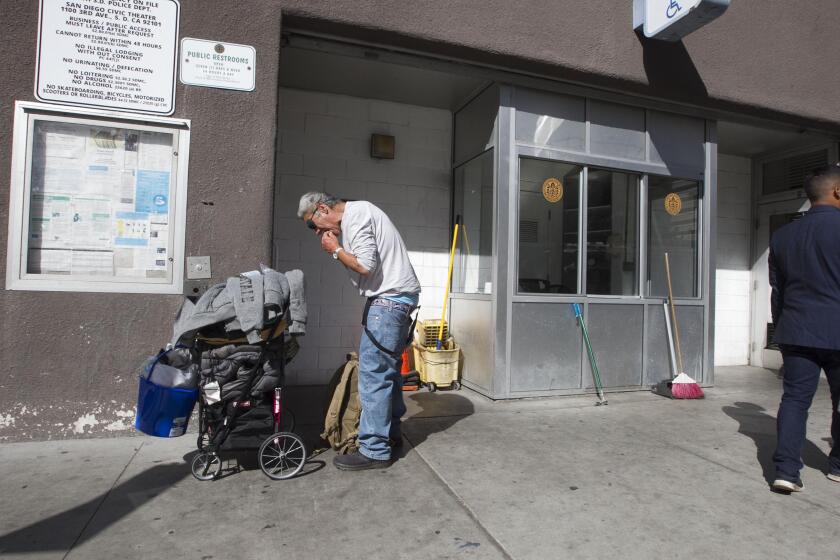California cities don’t have enough public bathrooms. Here’s one solution

- Share via
California has an opportunity to tackle a problem that affects everyone, but especially unhoused Californians: public restroom access. Unfortunately, there isn’t sufficient data about the scope of the problem for cities to move toward a solution.
A bill in the Assembly, AB 1297, introduced by Sharon Quirk-Silva (D-Fullerton), would require local governments to inventory public restrooms by July 2024, one step to address the chronic lack of restrooms across the state.
Access to public restrooms — facilities available to the general public that do not charge a fee for use — is a human right. Some groups rely more heavily on public facilities: people without stable housing, families with young children, delivery drivers and transit operators, tourists and commuters. But public restrooms are widely important for public health. Making available relatively clean and safe facilities promotes bladder and bowel health and prevents the spread of infectious diseases such as hepatitis A, shigella and influenza. Research shows that when more restrooms are available, open defecation declines.
It’s great when companies like Starbucks make their facilities available to all, but the responsibility really rests with governments. Paris and other cities show some paths forward.
Cities across California, however, have too few public restrooms to serve their populations. One recent estimate of access in Los Angeles, by far the state’s largest city with nearly 4 million residents, is especially grim: There are only 14 permanent public restrooms on city streets. L.A. has a network of portable toilets, but they can be here today and gone the next. Access to basic sanitation in skid row falls far short of international standards for refugee camps.
San Diego, California’s second-largest city, offers a telling case study. The city recently had to confront another uptick in hepatitis A cases — just a few years after a deadly hep A outbreak sickened nearly 600 people and killed 20 from 2016 lasting into 2018, and a 2021 shigella outbreak sickened 53 San Diegans. These outbreaks have repeatedly been linked to inadequate public restroom access, and they overwhelmingly affected unhoused people.
In response to these issues, my colleagues and I investigated a basic question: Where are the public restrooms in our community? We quickly learned that this is difficult to answer.
Information about public restrooms is sparse, hard to access and often inaccurate. San Diego County did not have a standardized database of public restrooms. Several of its municipalities have no public information on the restrooms they manage. We submitted public records requests to locate these facilities, then compiled the responses with publicly available information to develop an online map of all permanent public restrooms countywide. This inventory has basic information, including the facilities’ hours of operation and features offered such as menstrual products and baby changing stations.
The data paint an alarming picture. Focusing on downtown San Diego, we identified 22 public restrooms, only two of which are available 24/7. The overnight ratio is approximately one permanent toilet to every 204 unsheltered people living downtown. There are even fewer public restrooms in more outlying neighborhoods.
When we visited the downtown restrooms to audit their features, we found that only one of 22 offered hot water, four (18%) offered menstrual products, seven offered baby changing stations (32%) and nine (41%) offered a gender-neutral or “family” restroom option.
City officials are lobbying the state to lift its ban on pay toilets, contending the revenue could help them open more safe, clean restrooms. But homeless advocates are conflicted on whether it’s a good idea.
We also interviewed 115 unhoused San Diegans about their restroom experiences on a typical day. Of the people we interviewed, 70% reported using a public restroom — if one is available — and 44% reported practicing open defecation because no restroom is nearby when they need one. Half of the study participants said they experienced discrimination and other barriers when trying to use a restroom.
Passage of AB 1297 would be a critical first step toward increasing public restroom access. It is necessary for local governments to survey what restroom access looks like in their communities and make this information available to the public.
This is the not the first time Assemblywoman Quirk-Silva has tried to enact this policy. Opponents contend that a requirement to inventory public restrooms would burden local governments. But a better understanding of gaps in bathroom access would, over the long-term, reduce the work that officials have to put toward preventable public health crises directly linked to inadequate facilities.
The state can’t stop there. Once we know where restrooms are, we should use that information to improve the quality of existing facilities, identify where more are needed and explore creative solutions to increase access, such as public-private partnerships and corporate sponsors to create more restrooms.
California cities are perpetually at risk of infectious disease outbreaks. It’s time to collect the information needed to ensure that all Californians can safely meet their basic needs — and to hold local governments accountable to address this public health problem.
Megan Welsh Carroll is an associate professor of criminal justice and public administration at San Diego State and the director of the Project for Sanitation Justice. @bathrooms.sdsu
More to Read
A cure for the common opinion
Get thought-provoking perspectives with our weekly newsletter.
You may occasionally receive promotional content from the Los Angeles Times.








